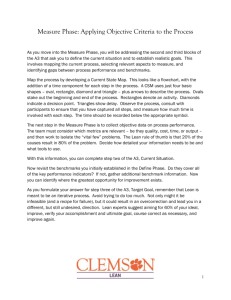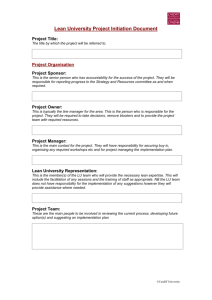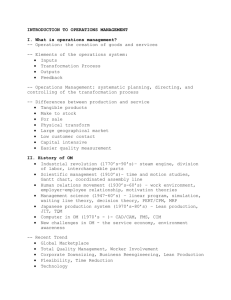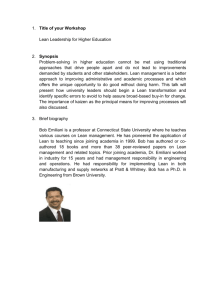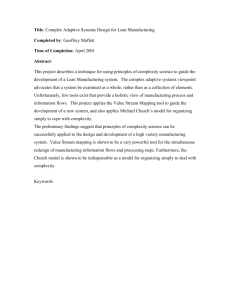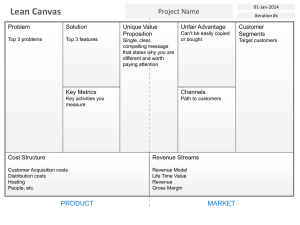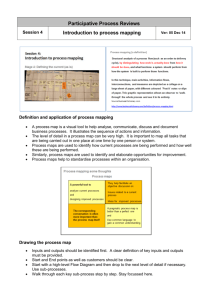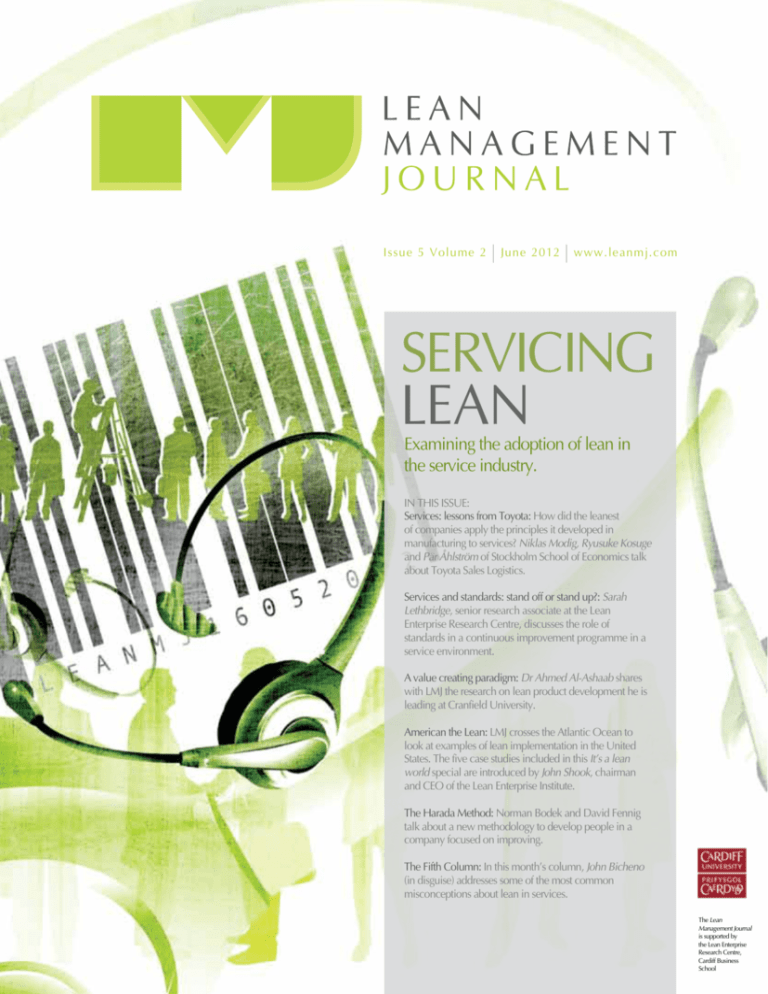
Issue 5 Volume 2
| June 2012 | www.leanmj.com
servicING
Lean
Examining the adoption of lean in
the service industry.
IN THIS ISSUE:
Services: lessons from Toyota: How did the leanest
of companies apply the principles it developed in
manufacturing to services? Niklas Modig, Ryusuke Kosuge
and Pär Åhlström of Stockholm School of Economics talk
about Toyota Sales Logistics.
Services and standards: stand off or stand up?: Sarah
Lethbridge, senior research associate at the Lean
Enterprise Research Centre, discusses the role of
standards in a continuous improvement programme in a
service environment.
A value creating paradigm: Dr Ahmed Al-Ashaab shares
with LMJ the research on lean product development he is
leading at Cranfield University.
American the Lean: LMJ crosses the Atlantic Ocean to
look at examples of lean implementation in the United
States. The five case studies included in this It’s a lean
world special are introduced by John Shook, chairman
and CEO of the Lean Enterprise Institute.
The Harada Method: Norman Bodek and David Fennig
talk about a new methodology to develop people in a
company focused on improving.
The Fifth Column: In this month’s column, John Bicheno
(in disguise) addresses some of the most common
misconceptions about lean in services.
The Lean
Management Journal
is supported by
the Lean Enterprise
Research Centre,
Cardiff Business
School
welcome
to the le a n
m a n a gement
journ a l
Dear reader,
We all have stories to tell about hours spent on the phone dealing with a
recorded voice, desperately trying to get through to (dreadful) customer
care. The service industry, arguably the one that makes our world go round
and employs most of us, desperately needs to adopt lean practices to better
understand customer requirements and concepts like respect for people. There is
also a great need to streamline processes that are too often disjointed, inefficient
and time-consuming. Still, the service sector is where continuous improvement
has had less of an impact compared to other areas. Many argue that lean
principles developed in and for manufacturing simply cannot work in a service
or office environment.
E ditori a l
Commissioning editor
Roberto Priolo
r.priolo@sayonemedia.com
Editorial director
John Bicheno
picsiebook@btinternet.com
Contributors
Tim Brown
Sub-editor
t.brown@sayonemedia.com
D esign
Art Editor
Martin Mitchell
m.mitchell@sayonemedia.com
Designers
Vicky Carlin, Alex Cole
Things are changing, however. As this issue of Lean Management Journal
shows, adopting lean in services is not only possible, but also necessary. A
number of articles in the June edition will help you to understand how lean
can be applied to services: on page 7, Niklas Modig, Ryusuke Kosuge and Pär
Åhlström of the Stockholm School of Economics explain how Toyota took the
principles it learned in manufacturing and applied them to services provided by
its dealerships in Japan.
Other contributions by Richard Bosworth and Erik Gillet (pages 16 and 19
respectively) analyse the differences between manufacturing and services with
regards to lean, in order to understand whether the traditional principles and
wastes are applicable to both in the same way.
This month’s Process Focus concentrates on lean design and product
development: I am sure Craig Squires’ article (page 30) on value engineering will
provide food for thought.
design@sayonemedia.com
In order to receive your copy
of the Lean Management
Journal kindly email b.walsh@
sayonemedia.com, telephone
0207 4016033 or write to the
address below. Neither the Lean
Management Journal or SayOne
Media can accept responsibilty for
omissions or errors.
Terms and Conditions
Please note that points of
view expressed in articles by
contributing writers and in
advertisements included in
this journal do not necessarily
represent those of the publishers.
Whilst every effort is made to
ensure the accuracy of the
information contained in the
journal, no legal responsibility will
be accepted by the publishers
for loss arising from use of
information published. All
rights reserved. No part of this
publication may be reproduced
or stored in a retrieval system
or transmitted in any form or by
any means without prior written
consent of the publishers.
This month, LMJ travels across the pond and visits a number of US companies,
for its It’s a lean world special on the United States produced in partnership with
John Shook’s Lean Enterprise Institute (page 34). Don’t miss, among others, the
inspiring case studies on Acme Alliance and, to go back to services, Starbucks.
It may seem impossible to think that 18,000 stores around the world, each
different from the next, can follow standard practices, but the Seattle-based
coffee company, which has now become one of the most recognisable brands
on the globe, has managed to create a great training programme to foster a
culture of improvement and encourage baristas to use ‘routines’.
A witty and thought-provoking Fifth Column by John Bicheno (page 44) will
help you to cement the lessons you will learn in this issue and draw some
conclusions. Additional comment is provided by editorial board members Bill
Bellows and Norman Bodek in our opinion section (on page 48).
The journal will soon launch its new website, leanmj.com – you don’t want to
miss it.
Stay tuned for more information! In the meantime, happy reading.
Commissioning Editor, Roberto Priolo
2
it ’ s a le a n world U S A
America
the L e a n
John Shook, chairman and CEO
of the Lean Enterprise Institute,
introduces LMJ’s special on lean
in the USA, identifying the key
lessons we can learn from the
case studies included in this
month’s edition.
34
In partnership with
it ’ s a
le a n world
T
he following five case studies
intend to inform us as to the
current state of lean thinking
and practice in the United States. So
what do they tell us?
First and foremost, the stories combine
to teach us that the roots of lean may
lie in automotive manufacturing, but
the fruits of lean are to be found in all
manner of industry and in all varieties of
activities in those industries.
Even at Ford, the story is not about
manufacturing in the plants (where
unfortunately Ford still lags woefully
behind). We learn from James Morgan
that the remarkable turnaround of
Ford Motor Company resulted from
rigorous application of lean practice in
engineering, product development, and
general management.
Similarly at Acme Alliance, the narrative is
not much about Acme’s plant floor; rather
the critical success for CEO Matt Lovejoy
and the profound lessons for us are to be
found in Acme’s alliance with its partners
in re-thinking and reconfiguring their
shared end-to-end value stream.
Medtronic is a manufacturer that bridges
two worlds, with factories producing
complex, precisely engineered products,
serving the demanding needs of the
healthcare sector. Medtronic’s Greg
Johnson shares the insights of a highly
complex company struggling with
the difficult yet common challenge of
spreading lean practice throughout its
deeply multifaceted, global organisation.
The Healthcare Value Network, in turn,
represents an approach to learning lean
that is especially appropriate for that
healthcare world, where the product
(health of humans) and producer (a
complex web of healthcare providers
with strong, varied, voices) present
unique challenges regarding the nature,
quality and timing of the delivery of
the product. The message delivered
by Helen Zak is that the collaborative
learning methodology of HVN fits the
requirements and opportunities of that
community especially well and could
serve as a model for the successful
introduction of lean thinking and
practice into other pioneering sectors.
While the battle of bringing lean thinking
and practice to healthcare is far from
over, there is enough momentum now
that there is no turning back. The same
cannot be said for services, where
efforts have only begun to scratch the
surface. Hence the Starbucks story is
extraordinarily timely and instructive.
While many seek to overthink and
complicate matters, Starbucks shows
that tried and true methodologies appropriately tweaked to match the
specific needs of the situation - can be
remarkably effective. The obvious place
to start in an organisation with 18,000
gemba locations would be supply chain.
Instead, the Starbucks lean team chose
to use lean thinking to provide their
baristas with the skills to do better
work design on their own, as they go
through the moment-to-moment, direct
customer-facing business of providing
patrons with exactly what they want
at the exact moment they want it.
This example illustrates the great folly
contained in the uninformed charge
that lean practice cannot be applied to
dynamic service environments.
While the battle of bringing
lean thinking and practice to
healthcare is far from over, there is
enough momentum now that there
is no turning back
Taken as a group, the five case studies
provide a good snapshot of the state
of lean dissemination in the United
States. It is heartening that the examples
provide evidence that progress is being
made in gaining broader understanding
that lean management is a holistic,
systemic approach to organisational
improvement. Understood thusly
(properly), lean thinking and practice
represents a powerful means of
improving any human endeavor, equally
satisfying for the customer, the worker,
and the enterprise.
In short, the report card on the state
of lean thinking and practice in the US:
much progress made – many challenges
and opportunities ahead.
www.leanmj.com | June 2012
35
it ’ s a le a n world U S A
A total
turnaround
Matthew Lovejoy, president
of Acme Alliance, shares
a personal account of the
transformation that the
company, which provides
components for technical manufacturing and
assembly, had to go through to survive.
I
only have five heroes in the world, and Jim
Womack is one of them. Simply put, lean saved
my business. From 1964 to 2001,
telecommunications corporation AT&T was our biggest
customer. After 1996 the phone industry in the States
was deregulated and the equipment arm of AT&T, Lucent
Technologies, was spun off. In 2001, the price of its
shares went from 80 dollars a share to 80 cents a share,
and we suddenly lost 95% of business with our main
customer, which represented 70% of our sales.
It was our burning platform. We understood that we
had to change drastically: Ericsson once came visiting
us in Chicago for an audit. Ten minutes into the audit,
the company’s engineer asked to be brought back to
the airport: like in a Charles Dickens novel, we were the
filthiest place you can imagine, with lots of WIP and
inventory, building everything in batches.
A customer of ours, Milwaukee Electronic Tool, that
had been a strong advocate of lean for years, suggested
I read Lean Thinking. Once I did, I realised everything
36
I thought I knew was wrong: in lean, until you accept
your baby is ugly you can’t make any progress.
We started by reorganising the business away from
functional designations, to destroy silo thinking.
Because we operate a high mix, low volume job shop,
we deal a lot with muri and mura, not just muda. We
then tried to achieve flow: we quickly noticed we were
covering six miles in the production of one part, in a
8,000 square metre site.
Being a family business, we have an intimate knowledge
of our employees. They understood right away we were
in trouble, and because we had been living modestly as
a business and saving money, I could keep Acme alive
without laying anyone off. Enthusiasm was palpable,
as we repainted, changed the layout (the architecture
in our Chicago site was very condescending, with
management offices with glass windows on the second
floor and speakers used to communicate with the staff
below), designed right sized equipment, and so on.
AT&T wouldn’t buy our inventory, and we burned it all
in our furnaces. The guys stayed and watched.
By moving to a flow environment, we envolved into
concepts of internal supermarkets and pull, building
only what customers wanted. We are now at a point
where 75% of our business is direct pull, same day
shipment, and our sales are back to where they were.
Our Brazilian and China businesses are thriving, and
thank God we had previously done that investment to
serve those growing markets (nothing is exported back
to the States). The Chinese and Brazilian foundries were
like sponges: we started those operations with a lean
orientation from day one.
Today we are a 99% on time supplier, with raw materials
down 95%. In ten years, revenue per employee has
doubled. Sales are back at old levels, although the
amount of finished goods is 60% lower.
We had to be excellent in order to just survive, and we
will never falter from the pursuit of this way of thinking.
www . le a nmj . com
56

